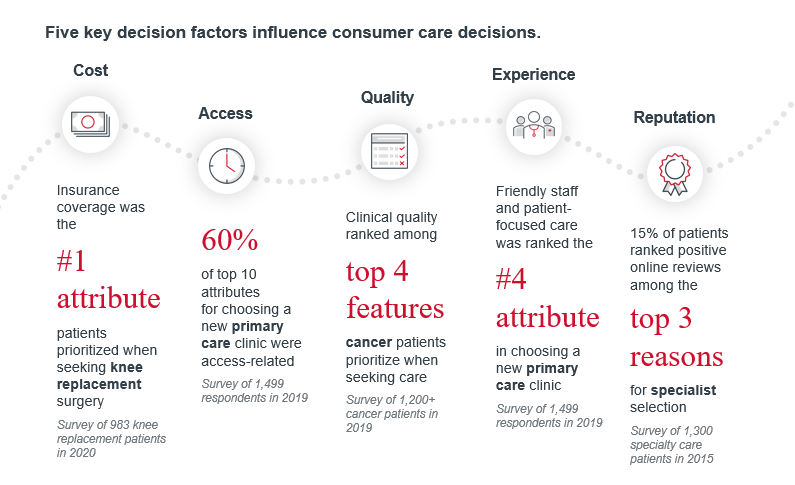Auto logout in seconds.
Continue LogoutHealthcare delivery is a changing landscape: between new disruptors, entrenched players launching differentiated access points, legislators shaping costs and price transparency, large health plans pushing for vertical integration, and more, winning consumer attention is challenging. It’s also a moving target, as these changes are continually reshaping consumer expectations and causing consumer preferences to evolve. Competing for consumers therefore requires a futureoriented focus to stay ahead of predicted changes.
Five factors heavily influence patient decisions: cost, access, quality, experience, and reputation. Analyzing how market forces are impacting these factors today can help you prepare to compete for future consumer preferences.

What’s happening?
Ambulatory surgery centers (ASCs), urgent care clinics, and direct and concierge primary care sites have grown in recent years, both in the number of sites and the scope of services offered. This is largely the result of disruptors and traditional health systems competing in the ambulatory space, and payer pressure to push more care out of the hospital. While these sites use cost to help distinguish themselves from hospital-based care, most compete with other ambulatory sites on access and convenience.

Why does this matter today?
Fifty-one percent of surveyed consumers indicated convenience and access ― including facility proximity to home and ability to take walk-ins ― as the most important factors in care decisionmaking in 2019. This demand continues to spur organizations to invest in access-related differentiators, which perpetually heightens consumer expectations for convenience.

Potential impacts of industry actions
Impact to stakeholder expected to be: + Positive - Negative ? Too soon to tell
+ Consumers will have more care options with more variety in cost and convenience.
? Device companies and suppliers will face a more fragmented market with new customers who have different purchasing and pricing expectations than hospitals.
+ Health plans will continue to see lower costs, as more ambulatory options mean more opportunities for health plans to incentivize less expensive care sites.
? Health systems will lose revenue from profitable services that shift to new settings, but those with ambulatory networks stand to gain from volume growth in outpatient services.
+ Physicians will see increased diversity of care settings and care model options.
Expected stakeholder actions
- Consumers: Will prioritize lower cost and more convenient care options, which will likely be ambulatory services when clinically appropriate.
- Device companies and suppliers: Will likely adjust their value proposition to appeal to freestanding providers, emphasizing their ability to drive surgical efficiency, reduce costs, and optimize supply chains.
- Health plans: Will adjust coverage to incentivize ambulatory services over inpatient services, both to accommodate consumer preferences and to lower costs. For some plans, this will include acquisition of ambulatory assets.
- Health systems: Will likely build, acquire, or partner with ambulatory facilities and enhance outpatient strategy to minimize lost revenue, remain competitive, and meet consumer demand.
- Physicians: Will explore emerging site of care options, taking into account their potential for higher volumes and more flexible hours.
What’s happening?
The number one concern for hospital CEOs in 2021 was personnel shortages, partly due to provider burnout. The primary reasons providers reported leaving their jobs ― for other jobs, different industries, or retirement ― were insufficient staffing, workload intensity, emotional toll of their job, and feeling unsupported at work. Among the many impacts of the resulting staffing shortages are poorer health outcomes for patients and less timely access to care.

Why does this matter today?
Care quality is paramount, but consumers also seek timely and convenient care, and they may switch providers when their expectations aren’t met. For example, a 2022 CVS Health survey revealed that 39% of consumers would go to urgent care instead of another provider in their doctor’s office if they weren’t able to see their regular PCP quickly. This means that workforce challenges are having market share impacts, since it’s often non-hospital employers who can offer employees more flexibility and lower stress ― thereby helping them compete for access-conscious consumers.

Potential impacts of industry actions
Impact to stakeholder expected to be: + Positive - Negative ? Too soon to tell
- Consumers will face worse overall care experiences (including worse outcomes and longer wait times) at understaffed facilities, especially for inpatient care.
+ Digital health companies will continue to see opportunities to recruit healthcare workers and heightened demand for automated technology to help alleviate staffing shortages and burnout.
- Health systems will continue to lose workers to more flexible, lower stress places of work and may have a harder time competing for patients as wait times for shoppable care lengthen and quality scores decline.
? Physicians may see expanded employment opportunities ― or, as wait times increase, they could see more frustrated and less healthy patients, which can perpetuate burnout cycles.
Expected stakeholder actions
- Consumers: Will seek facilities that have better patient reviews, reputations, and wait times, or defer care entirely if they feel that consistent, high-quality providers are unavailable.
- Digital health companies: Will continue to attract providers if they can maintain recruitment, strengthening digital workforce solutions.
- Health systems: Will fight to remain competitive both among employees and consumers. Although traditional recruitment and retention efforts remain important, they are no longer sufficient in the current environment. To remain a top choice among consumers, health systems will need to ensure adequate staffing or invest in staffing supplements (ex. automated technology) to meet the service demand.
- Physicians: Will continue seeking places of work that offer more flexibility and support ― likely at ambulatory and freestanding sites, with Big Tech and Retail providers, or in other sectors of the healthcare industry.
What’s happening?
Rising inflation, a looming recession, and slowed investing have compounded to create unstable economic conditions. Inflation began to spike in the United States in April of 2021, steadily climbing throughout 2022 until the rate peaked at 9.1% in June. Therefore, Americans paid more for almost everything, including health services, despite an overall decrease in income for middle-income households over the last three years.

Why does this matter today?
Consumers face higher out-of-pocket healthcare costs and premiums and more limited healthcare benefits under current economic conditions. They’re wary of unexpected costs and trying to manage unknowns by looking for advanced pricing info. As a result, they’re more stringent with their care decisions today and apt to reward organizations who can give them clear answers on costs, even if they aren’t ultimately the lowest cost option. Additionally, some consumers are deferring care due to high costs of healthcare services (46%) and higher costs of living overall (43%).

Potential impacts of industry actions
Impact to stakeholder expected to be: + Positive - Negative ? Too soon to tell
- Consumers will continue to grapple with less affordable care.
+ Digital health companies will benefit from increased demand for their products and services as plans prioritize virtual-first offerings and consumers seek cheaper virtual care options and price transparency tools.
- Government will face pressure to stimulate the economy and provide relief to struggling Americans.
- Health systems will be limited in expansion and innovation capabilities due to margin pressures, which may lead them to fall short of consumer expectations.
- Physicians may face decreasing volumes as patients defer or delay care due to high costs.
Expected stakeholder actions
- Consumers: Will delay care or defer entirely to avoid high medical expenses. They will likely put pressure on government agencies, health systems and providers, and health plans to lower costs and offer intuitive price transparency tools.
- Digital health companies: Will build price transparency tools and will likely face pressure from consumers and regulators to enhance their comprehensiveness and user friendliness. Additionally, they will expand virtual capabilities as a cheaper alternative to in-person care.
- Government: Will likely cut corners to reduce spending, but they may eventually provide stimulus and relief funding to consumers as pressure mounts.
- Health systems and physicians: Will struggle to maintain patient volumes as consumers forgo care. Progressive hospitals will likely expand cheaper inpatient care options, and some may see it as a strategic imperative to shift to more ambulatory and virtual services to reduce costs.
What’s happening?
Social distancing necessities and payment parity during the pandemic accelerated the use of digital health tools, allowing for the expansion of services like remote patient monitoring and virtual visits. While virtual visit utilization has fallen since its peak in Spring 2020, consumers’ increased exposure to virtual delivery channels has reset their standard for access and convenience. Today, about 10% of outpatient visits occur virtually (as opposed to about 1% pre-2020).
Why does this matter today?
Virtual care has led consumers to expect ondemand access as a normal service, not a differentiator. That means those who are trying to compete for access ― and convenience-hungry consumers ― are trying to push the boundaries of virtual and in-person care even further.


Uptake of digital health tools has increased among consumers of all age groups and will continue to rise as capabilities expand within chronic and specialty care.
Potential impacts of industry actions
Impact to stakeholder expected to be: + Positive - Negative ? Too soon to tell
? Consumers will continue to see increased digital care options that optimize convenience, but consumers without internet or electronic devices will struggle to access virtual services.
+ Device companies and suppliers will likely see increased demand for support for virtual and on-demand services to keep up with health plan and consumer preferences.
+ Digital health companies will see rising demand for virtual health services in primary care, chronic disease management, specialty care, and follow-up appointments, as well as for more affordable remote patient monitoring capabilities.
+ Health plans will benefit from lower cost virtual services, which are typically less expensive than in-person care.
- Health systems and physicians will face pressure to expand digital care offerings while they may lose revenue from in-person services.
Expected stakeholder actions
- Select consumer groups: Will seek virtual care when clinically appropriate and will pressure providers, health systems, and health plans to expand access to digital health services. This includes potentially switching providers for better access.
- Digital health companies: Will continue to grow offerings and will likely aim for a more holistic approach to telehealth, likely with a focus on interoperability and asynchronous offerings, to keep up with virtual visit demand and to combat disruptions to the continuum of care.
- Health plans: Will continue to incentivize virtual services over in-person services to lower the cost of care but will eventually feel the impacts of care fragmentation if they don’t move to improve coordination among providers and sites of care.
- Health systems and physicians: Will expand their digital care offerings with variable success, depending on the type of investments they make, how much they are willing to invest, and ability to integrate those digital offerings into care pathways and clinician workflows.
What’s happening?
A recent survey from CNN and KFF indicates that 90% of Americans agree the United States is experiencing a mental health crisis, and over 30% of U.S. adults report struggling with their mental health. The taboo, however, is lessening. In 2019, an APA poll found that 87% of American adults agreed that having a mental health disorder is nothing to be ashamed of, and 86% said they believe that people with mental health disorders can get better. The pandemic further drove conversations around the deteriorating state of Americans’ mental health, helping to destigmatize seeking care for mental health needs.
Why does this matter today?
The poor state of population-level mental health in the U.S. ― paired with the growing societal emphasis on mental health and wellbeing ― has led consumers to prioritize mental health and wellness services in several ways.

While they may be more willing to seek mental healthcare, many consumers are inhibited by costs: nearly 30% of consumers said they did not visit a mental health specialist due to the cost. This effect is magnified in younger segments of the population. One study found that 74% of young adults in the U.S. did not seek mental health services during the pandemic due to costliness, despite being the most likely age group to report depression.
Potential impacts of industry actions
Impact to stakeholder expected to be: + Positive - Negative ? Too soon to tell
? Consumers will continue to see a gap between demand for and access to mental healthcare.
+ Digital health companies will see rising demand for virtual and tech-driven mental healthcare.
+ Employers will need to establish or expand employee wellness efforts to be desirable among employees — an investment that could pay dividends through increased presenteeism and a healthier workforce, if interventions are successful.
+ Health plans will see pressure to meaningfully cover mental health and wellness services.
- Health systems will likely see growing demand for mental healthcare that many will struggle to meet, and they may see growing demand for more holistic wellness services, especially among younger patients.
? Pharmaceutical companies may see increased demand for medications for mental health, but they may also experience a shift to non-medication solutions like therapy.
? Physicians will have more opportunities to join virtual platforms and other tech startups to deliver virtual-only mental healthcare services, and they may find their patients are more receptive to following referrals to behavioral health services. Some may struggle to access the mental health support they need.
Expected stakeholder actions
- Consumers: Will seek employers and health plans that offer benefits and coverage for mental health and wellness services, and providers that offer convenient, affordable, and supportive mental health services.
- Digital health companies: Will expand virtual capabilities for mental healthcare.
- Employers: Will iterate on benefits packages, including more mental health support services and better coverage, and invest in more flexible, supportive company cultures to help recruit and retain talent.
- Health plans: Will move to expand coverage of mental healthcare and might eventually include non-traditional wellness services like acupuncture and massage therapy.
- Health systems: Will struggle to accommodate the growing demand for mental healthcare, including inpatient psychiatric care and outpatient services like therapy. Some will likely adjust their services to stay competitive.
- Pharmaceutical companies: Will seek growth opportunities in psychiatric medical solutions. They might need to revamp their marketing efforts to establish pharmaceutical solutions as holistic and low-risk, high-reward.
Don't miss out on the latest Advisory Board insights
Create your free account to access 1 resource, including the latest research and webinars.
Want access without creating an account?
You have 1 free members-only resource remaining this month.
1 free members-only resources remaining
1 free members-only resources remaining
You've reached your limit of free insights
Become a member to access all of Advisory Board's resources, events, and experts
Never miss out on the latest innovative health care content tailored to you.
Benefits include:
You've reached your limit of free insights
Become a member to access all of Advisory Board's resources, events, and experts
Never miss out on the latest innovative health care content tailored to you.
Benefits include:
This content is available through your Curated Research partnership with Advisory Board. Click on ‘view this resource’ to read the full piece
Email ask@advisory.com to learn more
Click on ‘Become a Member’ to learn about the benefits of a Full-Access partnership with Advisory Board
Never miss out on the latest innovative health care content tailored to you.
Benefits Include:
This is for members only. Learn more.
Click on ‘Become a Member’ to learn about the benefits of a Full-Access partnership with Advisory Board
Never miss out on the latest innovative health care content tailored to you.


